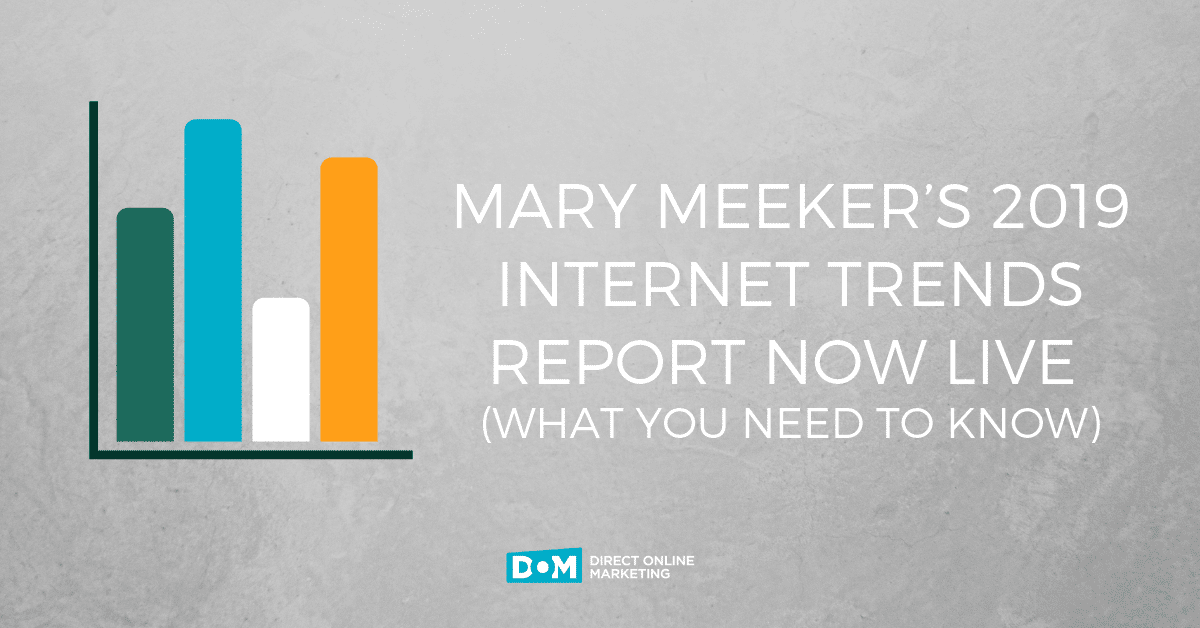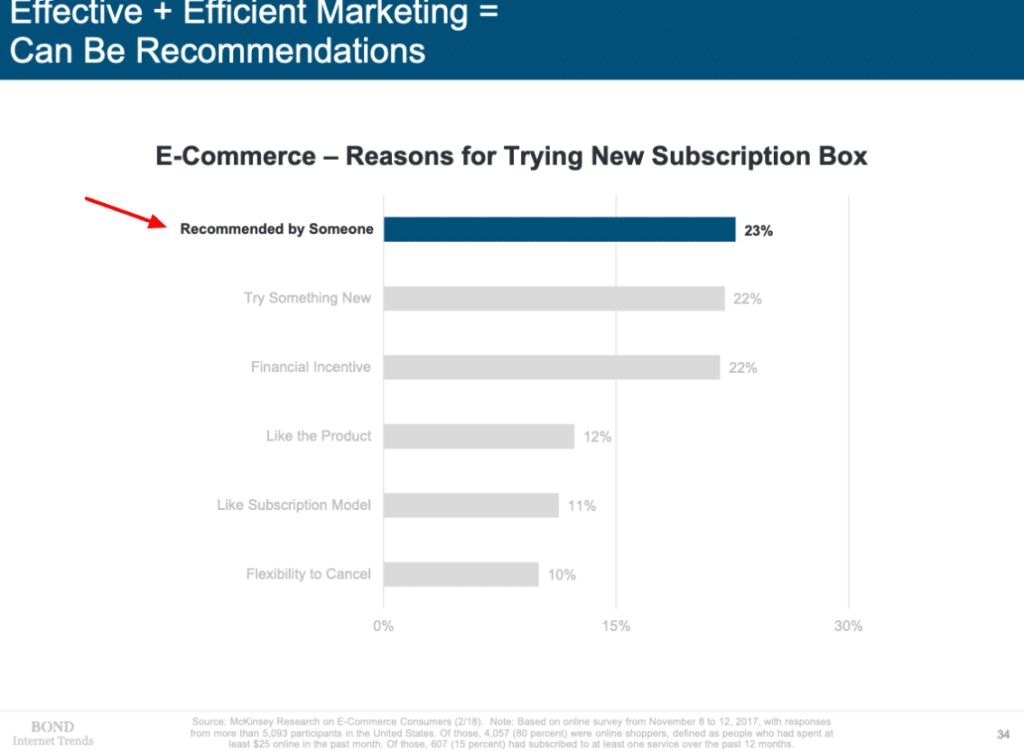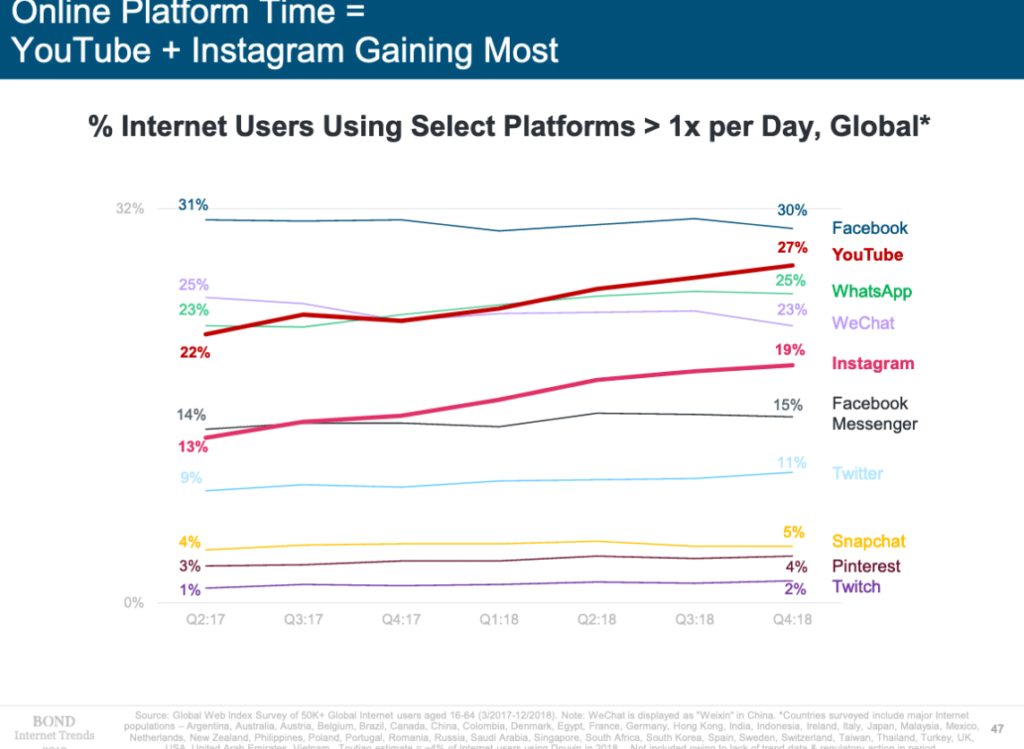
The Internet is growing, but not as fast as you’d think (I explain that at the end).
On Tuesday, June 11, Mary Meeker’s Internet Trends Report for 2019 hit stands. By stands, I mean the Internet; the same Internet that’s slowly growing, according to the report. But Internet growth slowing down is overshadowed by increasing trends in e-commerce sales and advertising spends. Oh yeah, the TV is not as cool as our mobile devices…who knew? All of us, I suspect.
There’s a lot to unpack here. Some of the report’s stats are expected, others are a little surprising.
Let’s break down the essentials, or, what you need to know.
Mary Meeker Report: Online Advertising
Let’s do this.
Digital Marketers Are Buying Ads… Lot’s of Them
Internet ad spending numbers continue to thrive. The 2019 Meeker report shows that ad spends are up 22% overall.
Unsurprisingly, the big dogs, Google, Facebook, Amazon, and Twitter, are dominating the market. All of them continue to trend up.
However, it’s noteworthy to observe that Twitter, Amazon, Snapchat, and Pinterest gained more percentage-wise than Facebook or Google. Clearly, as a digital marketer, this should serve to signal a shift in ad buying opportunities.
Another big takeaway is the narrative that has Facebook and Google, the two most dominant advertising platforms, losing market share. It’s nothing to write home about yet, but it does show a small shift in the market.
Ad Platform Sophisticated Targeting Driving Spends Up
Why are marketers spending more money than ever on ad platforms? Simply stated, the targeting is more refined than ever.
Google and Facebook are both leveraging machine learning to improve ad targeting. This means marketers are able to create more precise, profitable campaigns in shorter time spans. Marketers are placing more relevant ads in front of users who have a need for those ad’s products and services.
Google, in particular, is using artificial intelligence to assist in areas such as voice search. Using data-driven advertising strategies is a fruitful venture.
Google and Facebook Make Organic Reach More Challenging
Another often ignored the reason for increased ad spends may well be the vast decrease in organic reach. Facebook’s organic reach apocalypse can be traced back to 2014. Most pages see an average reach of 2%, at most.
Critics of Google’s advertising platform believe the search giant is making it more and more difficult to tell organic listings from paid listings. Last week, Google’s design team helped to quell some concerns over a user’s ability to distinguish between ads and organic listings. But the issue is certain to remain prominent throughout 2019.
Dear Marketers, Free Trials Are Winning
Have you ever left an online streaming service for a competitor? Most likely, you have. You probably assume most people switch streaming providers because of competing for content libraries. Game of Thrones is gone, off to Ray Donovan, right?
Actually, you’re wrong.
While there are a number of factors that contribute to a person swapping streaming services, the most prominent reason is free trial offers. Behind free trial offers, content library, exclusive content, and user experience follow.
Most People Are Multi-Digital-Tasking
The report, by way of the Nielsen Audience Report, also reveals that 88% of people use a second digital device while watching television. About 71% of these people look up content while watching television. Beyond that, 41% of people message their friends regarding the show their watching.
What’s the big takeaway?
In terms of SEO and content marketing, this explains an obvious trend. Search terms can fluctuate heavily depending on what people are watching. There are no surprises here, however, it’s good information for content marketers looking to take advantage of trending topics.
Mobile Usage Is Now Beating TV Usage
Again, nothing earth shattering in this news, but mobile device time has finally bypassed our good old TVs.
The Freemium Market Is Healthy, Also
Spotify is crushing it.
Their freemium model now accounts for 60% of gross added premium subscribers, according to Barry McCarthy, the company’s CFO. Spotify uses the ad-based service to infuse cash to offset acquiring new subscribers.
Additionally, the Meeker report also points out that Zoom is having similar freemium success. Eric Yuan, Zoom’s founder, says in the report that the freemium model helps the company generate leads with less marketing spend.
Moreover, subscription models are thriving based on user recommendations.
Tell a friend about my article. Please. Because, yes, it works.
Privacy Issues Complicate Paid Ad Marketing
There is no question that privacy concerns are one of the top issues of 2019. Both Facebook and Google continue to quell user privacy concerns with numerous changes in data privacy. In 2018, the General Data Protection Regulation (GDPR), tightened privacy laws on a global level. The consequences had website operators scrambling for solutions on implementation.
Speaking of Privacy, Those Amazon Echo Devices…
Critics of online privacy issues have certainly not been shy in their disappointment with Amazon’s Echo device. The device has frequently come under fire for the way it manages it’s user recordings. But I’m not going to get into that, mostly because I’ve discussed it before and Amazon employees have heard me loud and clear (sorry, I had to).
The issue is likely to become more pronounced as the devices continue to fly off the shelves.
The core capacity of the device is deeply seeded in recording user voice commands. Amazon, like Facebook and Google, will need to manage privacy concerns by way of more modern disclosures and changes to the way recordings are stored.
E-commerce vs. Brick and Mortar
Meeker’s report shows a 12% growth in e-commerce sales while physical retail growth hovered at a more modest 2%.
Overall, e-commerce sales contribute to 15% of overall sales in the United States.
Internet Growth Is Slowing But Still Growing
Slow and steady, she goes. According to the report, the Internet remains in a growth pattern, but as you can see from one of the report’s first slides, that growth is slowing.

There’s not a ton to take away here that’s not obvious. From a big picture perspective, the Internet’s remaining third world opportunities are becoming more difficult to reach. Given the fact that 50% of the world is online, that’s not a shocking statistic.
In 2018, The Guardian reported that this downward trend began in 2015. This trend doesn’t detrimentally affect digital marketers unless you consider international reach. Instead, it’s a sign that a portion of the world remains economically challenged and isolated.
“We underestimated the slowdown and the growth rate is now really worrying,” said Dhanaraj Thakur, research director at the Web Foundation, told The Guardian. “The problem with having some people online and others not is that you increase the existing inequalities. If you’re not part of it, you tend to lose out.”
In 2017, the UN predicted that overall online penetration would hit 50% by 2017. According to Meeker’s report, we’ve done that and more. But it is difficult to ignore a troubling Internet penetration slowdown. This means that portions of the world with the most need for economic opportunities are being left in the dark. The Internet’s value, on a socioeconomic level, is often found in increased access to education and remote work opportunities. The slow down in the Internet reach signals a blockade for these opportunities which could serve to further harm already struggling socioeconomic classes in third world nations.
Africa and Asia Online vs. Offline Disparity
Slide 10 puts the issue on further display. Note the disparity of on and offline users in Asia and Africa.
China Remains a Big Dog
China remains the country with the most online users overall, followed by India and the United States.
No surprises here, China and India are both vastly populated regions. But China remains in a censorship struggle which continues to limit digital marketers who leverage Google Ads.
The United States Controls Internet Marketing Capitalization
Five U.S. companies control total Internet market cap value.
- Microsoft
- Amazon
- Apple
Beyond that, China-based Alibaba and Tencent come in at 6 and 7. Netflix, while growing, remains in the 8 spot.
Instagram Is Gaining In Online Platform Time
While Instagram isn’t the biggest social media platform, the Facebook-owned entity is gaining hugely in online platform statistics.
Some of this may be attributed to hostile political bubbles battling on Facebook. Additionally, Facebook’s privacy settings can be confusing. Many people don’t love when others see what they like or comment on. Instagram is more image-based and doesn’t put user engagement on full display (at least when compared to Facebook).
In The U.S., People Are Online (A Lot)
Digital media usage for those with Internet access is growing. That’s not earth-shattering news, of course. In the United States, users spend an average of 6.3 hours on a digital device per day. 3.6 of those hours are specific to mobile devices.
Other Takeaways Digital Marketers Need To Know
Mary Meeker’s report, which you can find in full here, clearly indicates that digital advertising spends are rising, signaling a shift in the way that ad platforms use artificial intelligence and targeting. The cost to buy ads, unsurprisingly, continues to rise alongside. Additionally, we might consider that both Google and Facebook are making organic reach a more difficult prospect.
So regardless of your industry, if Google, Facebook, Amazon, or any of the other major digital platforms are crucial to the ongoing growth of your company, you need to be shifting more dollars and targeted efforts towards advertising there. The costs are only going to go up, and the targeting methods are only going to get better
Another thing this report gives digital marketers to consider: how can you draw more customers or better prospects into your product or service with a free trial or freemium offer? Try it before you buy it has become mainstream online, and taking that approach to customer acquisition will help you stand out in your niche if no one else is doing it.
Here are three other interesting takeaways we picked up from reviewing the 333 slide deck.
- The Internet is beginning to slow its reach. The consequences of this slowdown for socioeconomically challenged regions in the world may be devastating.
- TV’s are finally second to mobile devices.
- People text friends and family while watching TV. (But hey, we knew that, didn’t we?)
To get more information on this topic, contact us today for a free consultation or learn more about our status as a Google Partner Agency before you reach out.













